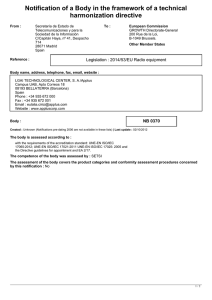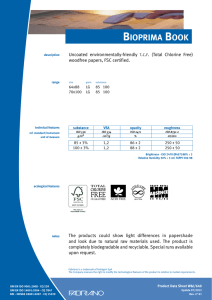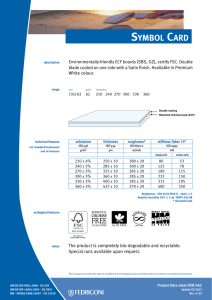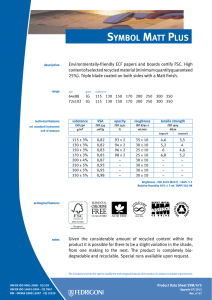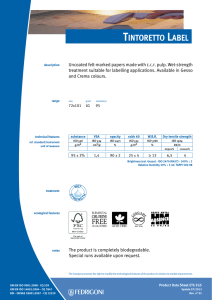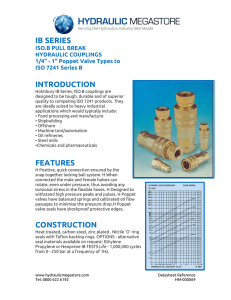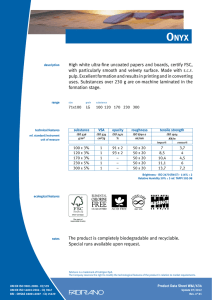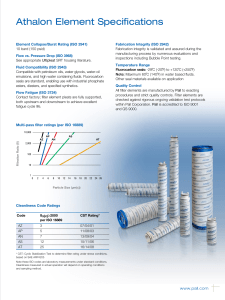iso iec guide 51 2014e---safety-aspects----guidelines-for-their-inclusion-in-standards
Anuncio
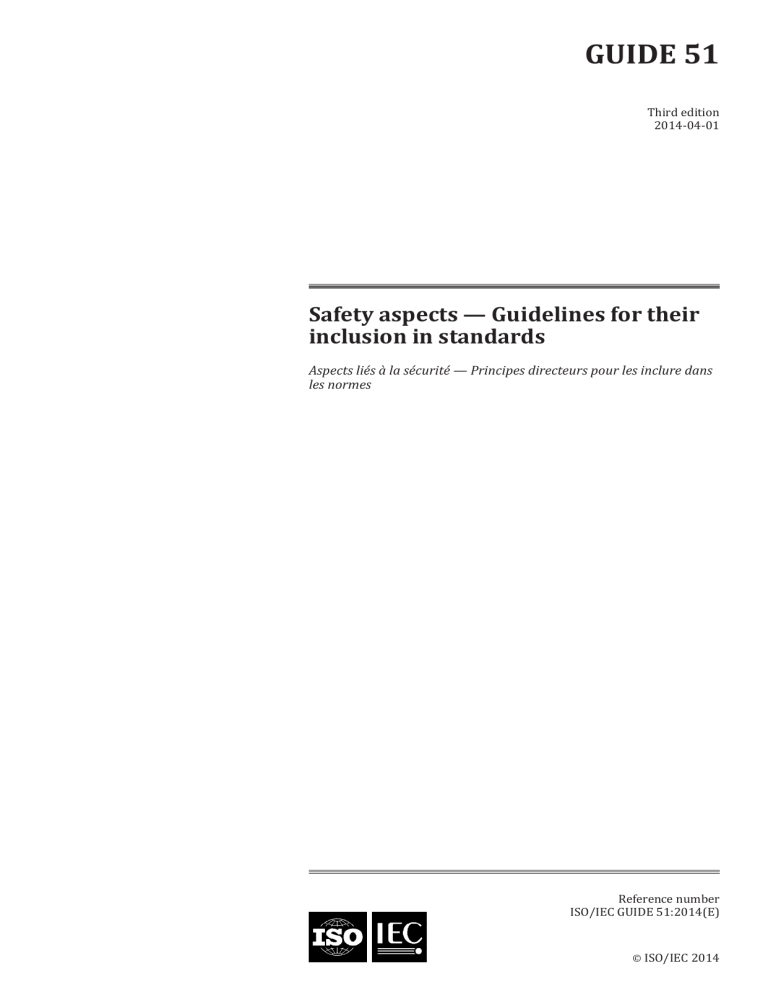
GUIDE 51 Third edition 2014-04-01 Safety aspects — Guidelines for their inclusion in standards Aspects liés à la sécurité — Principes directeurs pour les inclure dans les normes Reference number ISO/IEC GUIDE 51:2014(E) © ISO/IEC 2014 ISO/IEC GUIDE 51:2014(E) COPYRIGHT PROTECTED DOCUMENT © ISO/IEC 2014 All rights reserved. Unless otherwise specified, no part of this publication may be reproduced or utilized otherwise in any form or by any means, electronic or mechanical, including photocopying, or posting on the internet or an intranet, without prior written permission. Permission can be requested from either ISO at the address below or ISO’s member body in the country of the requester. ISO copyright office Case postale 56 • CH-1211 Geneva 20 Tel. + 41 22 749 01 11 Fax + 41 22 749 09 47 E-mail [email protected] Web www.iso.org Published in Switzerland ii © ISO/IEC 2014 – All rights reserved ISO/IEC GUIDE 51:2014(E) Contents Page Foreword......................................................................................................................................................................................................................................... iv Introduction...................................................................................................................................................................................................................................v 1 2 3 4 5 6 7 Scope.................................................................................................................................................................................................................................. 1 Normative references....................................................................................................................................................................................... 1 Terms and definitions...................................................................................................................................................................................... 1 Use of the terms “safety” and “safe”................................................................................................................................................... 3 Elements of risk...................................................................................................................................................................................................... 3 Achieving tolerable risk................................................................................................................................................................................. 4 6.1 Iterative process of risk assessment and risk reduction..................................................................................... 4 6.2 Tolerable risk............................................................................................................................................................................................. 5 6.3 Risk reduction........................................................................................................................................................................................... 6 6.4 Validation...................................................................................................................................................................................................... 8 Safety aspects in standards........................................................................................................................................................................ 8 7.1 Types of safety standard.................................................................................................................................................................. 8 7.2 Analysis of proposed new standards.................................................................................................................................... 9 7.3 Preparatory work.................................................................................................................................................................................. 9 7.4 Drafting........................................................................................................................................................................................................ 10 Bibliography.............................................................................................................................................................................................................................. 14 © ISO/IEC 2014 – All rights reserved iii ISO/IEC GUIDE 51:2014(E) Foreword ISO (the International Organization for Standardization) and IEC (the International Electrotechnical Commission) are worldwide federations of national standards bodies (ISO member bodies and IEC national committees). The work of preparing International Standards is normally carried out through ISO and IEC technical committees. Each member body interested in a subject for which a technical committee has been established has the right to be represented on that committee. International organizations, governmental and non-governmental, in liaison with ISO or IEC, also take part in the work. ISO collaborates closely with IEC on all matters of electrotechnical standardization. International Standards are drafted in accordance with the rules given in the ISO/IEC Directives, Part 2. Draft Guides adopted by the responsible Committee or Group are circulated to the member bodies for voting. Publication as a Guide requires approval by at least 75 % of the member bodies casting a vote. Attention is drawn to the possibility that some of the elements of this document may be the subject of patent rights. ISO and IEC shall not be held responsible for identifying any or all such patent rights. ISO/IEC Guide 51 was prepared by a Joint Working Group of the ISO Committee on Consumer Policy (COPOLCO) and the IEC Advisory Committee on Safety (ACOS). This third edition cancels and replaces the second edition (ISO/IEC Guide 51:1999) which has been technically revised. The main changes compared with the second edition are as follows: — strengthened focus on risk reduction in the overall risk assessment process, including revised Figure 2; — replacement of the term “harmful event” with the term “hazardous event”; — updating of terms used in the context of consumer safety; — revision of Figure 3 to specify the risk reduction steps in greater detail; — addition of a new Introduction providing more background information; — addition of specific provisions and references relative to vulnerable consumers; — revision of Clause 2 (Normative references) and the Bibliography; — reorganization and consolidation of the content in Clauses 6 and 7. iv © ISO/IEC 2014 – All rights reserved ISO/IEC GUIDE 51:2014(E) Introduction Work on standards deals with safety aspects in many different forms across a wide range of technologies and for most products, processes, services and systems (referred to as “products and systems” in this Guide). The increasing complexity of products and systems entering the market makes it necessary to place a high priority on consideration of safety aspects. This Guide provides practical guidance to drafters of standards to assist them in including safety aspects in standards. The underlying principles of this Guide can also be used wherever safety aspects require consideration, and as a useful reference for other stakeholders such as designers, manufacturers, service providers, policy makers and regulators. The approach described in this Guide aims at reducing risk that can arise in the use of products or systems, including use by vulnerable consumers. This Guide aims to reduce the risk arising from the design, production, distribution, use (including maintenance) and destruction or disposal of products or systems. The complete life cycle of a product or system (including both the intended use and the reasonably foreseeable misuse) is considered, whether the product or system is intended to be used in the workplace, in the household environment, or for recreational activities. The goal is to achieve tolerable risk for people, property and the environment, and to minimize adverse effects on the environment. Hazards can pose different safety problems and can vary significantly depending on the end user of a product or system, including the integrity of control mechanisms, and the environment in which a product or system is used. Whereas it is possible to control risks to a greater extent in the workplace, this might not be the situation in the home environment or when vulnerable consumers use the product or system. Consequently, this Guide might need to be supplemented by other publications for particular fields of interest or users. An indicative list of such publications appears in the Bibliography. This Guide is intended to be applicable to the drafting of all new standards and to existing standards at their next revision. It is important to distinguish the respective roles of quality and of safety. However, it might be necessary to consider quality requirements in standards to ensure that the safety requirements are consistently met. NOTE 1 The term “standard” used throughout this Guide includes international standards, technical specifications, publicly available specifications, technical reports and guides. NOTE 2 Standards can deal exclusively with safety aspects or can include clauses specific to safety. NOTE 3 Unless otherwise stated, when the term “committee” is used in this Guide, it refers to technical committees, subcommittees or working groups of both ISO and IEC. © ISO/IEC 2014 – All rights reserved v GUIDE ISO/IEC GUIDE 51:2014(E) Safety aspects — Guidelines for their inclusion in standards 1 Scope This Guide provides requirements and recommendations for the drafters of standards for the inclusion of safety aspects in standards. It is applicable to any safety aspect related to people, property or the environment, or to a combination of these. NOTE 1 For example, it can be applicable to people only, or to people and property, or to people, property and the environment. NOTE 2 The term “products and systems” used throughout this Guide includes products, processes, services and systems. NOTE 3 Safety aspects can also be applicable to long-term health consequences. 2 Normative references There are no normative references. 3 Terms and definitions For the purposes of this document, the following terms and definitions apply. 3.1 harm injury or damage to the health of people, or damage to property or the environment 3.2 hazard potential source of harm (3.1) 3.3 hazardous event event that can cause harm (3.1) 3.4 hazardous situation circumstance in which people, property or the environment is/are exposed to one or more hazards (3.2) 3.5 inherently safe design measures taken to eliminate hazards (3.2) and/or to reduce risks (3.9) by changing the design or operating characteristics of the product or system 3.6 intended use use in accordance with information provided with a product or system, or, in the absence of such information, by generally understood patterns of usage © ISO/IEC 2014 – All rights reserved 1 ISO/IEC GUIDE 51:2014(E) 3.7 reasonably foreseeable misuse use of a product or system in a way not intended by the supplier, but which can result from readily predictable human behaviour Note 1 to entry: Readily predictable human behaviour includes the behaviour of all types of users, e.g. the elderly, children and persons with disabilities. For more information, see ISO 10377. Note 2 to entry: In the context of consumer safety, the term “reasonably foreseeable use” is increasingly used as a synonym for both “intended use (3.6)” and “reasonably foreseeable misuse.” 3.8 residual risk risk (3.9) remaining after risk reduction measures (3.13) have been implemented 3.9 risk combination of the probability of occurrence of harm (3.1) and the severity of that harm Note 1 to entry: The probability of occurrence includes the exposure to a hazardous situation (3.4), the occurrence of a hazardous event (3.3) and the possibility to avoid or limit the harm. 3.10 risk analysis systematic use of available information to identify hazards (3.2) and to estimate the risk (3.9) 3.11 risk assessment overall process comprising a risk analysis (3.10) and a risk evaluation (3.11) 3.12 risk evaluation procedure based on the risk analysis (3.10) to determine whether tolerable risk (3.15) has been exceeded 3.13 risk reduction measure protective measure action or means to eliminate hazards (3.2) or reduce risks (3.9) EXAMPLE Inherently safe design (3.5); protective devices; personal protective equipment; information for use and installation; organization of work; training; application of equipment; supervision. 3.14 safety freedom from risk (3.9) which is not tolerable 3.15 tolerable risk level of risk (3.9) that is accepted in a given context based on the current values of society Note 1 to entry: For the purposes of this Guide, the terms “acceptable risk” and “tolerable risk” are considered to be synonymous. 3.16 vulnerable consumer consumer at greater risk (3.9) of harm (3.1) from products or systems, due to age, level of literacy, physical or mental condition or limitations, or inability to access product safety (3.14) information 2 © ISO/IEC 2014 – All rights reserved ISO/IEC GUIDE 51:2014(E) 4 Use of the terms “safety” and “safe” 4.1 The term “safe” is often understood by the general public as the state of being protected from all hazards. However, this is a misunderstanding: “safe” is rather the state of being protected from recognized hazards that are likely to cause harm. Some level of risk is inherent in products or systems (see 3.14). 4.2 The use of the terms “safety” and “safe” as descriptive adjectives should be avoided when they convey no useful extra information. In addition, they are likely to be misinterpreted as an assurance of freedom from risk. The recommended approach is to replace, wherever possible, the terms “safety” and “safe” with an indication of the objective. EXAMPLES “Protective helmet” instead of “safety helmet”; “protective impedance device” instead of “safety impedance”; “slip resistant floor-covering” instead of “safe floor-covering”. 5 Elements of risk The risk associated with a particular hazardous situation depends on the following elements: a) the severity of harm that can result from the considered hazard; b) the probability of occurrence of that harm, which is a function of: — the exposure to the hazard; — the occurrence of a hazardous event; — the possibilities of avoiding or limiting the harm. The elements of risk are shown in Figure 1. Figure 1 — Elements of risk © ISO/IEC 2014 – All rights reserved 3 ISO/IEC GUIDE 51:2014(E) 6 Achieving tolerable risk 6.1 Iterative process of risk assessment and risk reduction The iterative process of risk assessment and risk reduction for each hazard is essential in achieving tolerable risk. The critical issue for drafters of standards to address, as a product or system goes through the supply chain from development to disposal, is to determine whether the iterative process of risk assessment is assumed by: — the standards drafting committee, to perform the risk assessment for specific and known hazards (e.g. a product-specific standard that is used to demonstrate regulatory compliance); or — the standard readers/users, to perform the risk assessment (e.g. manufacturer/supplier of the product or system) for hazards that they identify (e.g. based on ISO 12100 or ISO 14971). The following procedure should be used to reduce risks to a tolerable level (see Figure 2): a) identify the likely users for the product or system, including vulnerable consumers and others affected by the product; c) identify each hazard (including reasonably foreseeable hazardous situations and events) arising in the stages and conditions for the use of the product or system, including installation, operation, maintenance, repair and destruction/disposal; b) identify the intended use, and assess the reasonably foreseeable misuse, of the product or system; d) estimate and evaluate the risk to the affected user group arising from the hazard(s) identified: consideration should be given to products or systems used by different user groups; evaluation can also be made by comparison with similar products or systems; e) if the risk is not tolerable, reduce the risk until it becomes tolerable. Figure 2 shows the iterative process of risk assessment and risk reduction. 4 © ISO/IEC 2014 – All rights reserved ISO/IEC GUIDE 51:2014(E) Figure 2 — Iterative process of risk assessment and risk reduction 6.2 Tolerable risk 6.2.1 All products and systems include hazards and, therefore, some level of residual risk. However, the risk associated with those hazards should be reduced to a tolerable level. Safety (as defined in 3.14) is achieved by reducing risk to a tolerable level, which is defined in this Guide as tolerable risk. The purpose © ISO/IEC 2014 – All rights reserved 5 ISO/IEC GUIDE 51:2014(E) of determining the tolerable risk for a specific hazardous event is to state what is deemed acceptable with respect to both components of risk (see Figure 1). Tolerable risk can be determined by: — the current values of society; — the search for an optimal balance between the ideal of absolute safety and what is achievable; — the demands to be met by a product or system; — factors such as suitability for purpose and cost effectiveness. 6.2.2 It follows that there is a need to review the tolerable level, in particular when developments, both in technology and in knowledge, can lead to economically feasible improvements to attain the minimum risk related to the use of a product or system. NOTE The factors involved in reducing the overall risk to a level below the tolerable risk vary significantly depending on whether the product or system is used in the workplace, in a public environment or by a consumer in and around the home. In many cases, it is possible to control risks to a greater extent in the workplace through occupational training, protective procedures and equipment that workers are required to use. In contrast, this might not occur in a home or public environment. 6.2.3 Drafters of standards shall consider safety aspects for the intended use and the reasonably foreseeable misuse of products and systems, and apply risk reduction measures to achieve a tolerable risk level. 6.2.4 Drafters of standards shall also consider reasonably foreseeable uses of the product which, even if they are not intended uses, are readily predictable based on the collective experience of the end user population. In particular, when determining the risk posed by consumer products, consideration should be given for products that are intended for, or are used by, vulnerable consumers who are often unable to understand the hazard or the associated risk. 6.2.5 To many suppliers, it might seem that the end user does not use the product for its intended purpose or in the manner intended. However, predictable, known human behaviour should be considered in the design process. 6.3 Risk reduction 6.3.1 Drafters of standards should specify risk reduction measures to achieve a tolerable risk level for the products or systems concerned. Standards incorporating safety aspects should provide guidance on achieving tolerable risk. NOTE 1 During the preliminary design of a product or a system, inherently safe design measures are usually intuitively applied. Therefore, the risk evaluation for some hazards might lead to a positive outcome at the first iteration and no further risk reduction is required. NOTE 2 ISO/IEC Guide 50 gives guidance on the needs of children and ISO/IEC Guide 71 covers the needs of other vulnerable consumers, such as older persons or persons with disabilities. 6.3.2 Where hazards or hazardous situations with multiple risks have been identified, care should be taken to prevent risk reduction measures chosen to reduce one risk from resulting in another intolerable risk. 6.3.3 If there is more than one option for risk reduction given in a safety standard, the standard should clearly show how to determine the most appropriate method of reducing risk to a tolerable level, applying the principles of a risk assessment. 6.3.4 Figure 3 shows the principle of risk reduction by applying the “three-step method” at the design phase and additional measures at the use phase. 6 © ISO/IEC 2014 – All rights reserved ISO/IEC GUIDE 51:2014(E) Key a See also 7.4.2. b An example is the risk remaining in a product or a system when supplied to a customer, or in a structural feature, after installation. Figure 3 — Risk reduction: combination of efforts at design and use phase 6.3.5 When reducing risks, the order of priority shall be as follows: © ISO/IEC 2014 – All rights reserved 7 ISO/IEC GUIDE 51:2014(E) a) inherently safe design; c) information for end users (see 7.4.2). b) guards and protective devices; Inherently safe design measures are the first and most important step in the risk reduction process. This is because protective measures inherent to the characteristics of the product or system are likely to remain effective, whereas experience has shown that even well-designed guards and protective devices can fail or be violated, and information for use might not be followed. Guards and protective devices shall be used whenever an inherently safe design measure does not reasonably make it possible either to remove hazards or to sufficiently reduce risks. Complementary protective measures involving additional equipment (e.g. emergency stop equipment) might have to be implemented. The end user has a role to play in the risk reduction procedure by complying with the information provided by the designer/supplier. However, information for use shall not be a substitute for the correct application of inherently safe design measures, guards or complementary protective measures. 6.4 Validation Standards should include guidance to validate the implemented risk reduction measures, including: — their effectiveness, e.g. test methods; — the risk assessment procedure that has been followed; — the documentation of the outcome of the risk assessment. 7 Safety aspects in standards 7.1 Types of safety standard Close coordination is necessary within and among committees responsible for preparing standards on different products and systems, in order to achieve a coherent approach to the reduction of risk. The use of a structured approach is recommended to ensure that each specialized standard is restricted to specific aspects and makes reference to wider-ranging standards for all other relevant aspects. The structure is built on the following types of standard: — basic safety standard, comprising fundamental concepts, principles and requirements with regard to general safety aspects applicable to a wide range of products and systems; — group safety standard, comprising safety aspects applicable to several products or systems, or a family of similar products or systems, dealt with by more than one committee, making reference, as far as possible, to basic safety standards; — product safety standard, comprising safety aspects for a specific product or system, or a family of products or systems, within the scope of a single committee, making reference, as far as possible, to basic safety standards and group safety standards; — standards containing safety aspects, but which do not deal exclusively with safety aspects, making reference as far as possible to basic safety standards and group safety standards. NOTE 1 NOTE 2 See IEC Guide 104 for a structured approach in the fields of electrical and electronic engineering. See ISO Guide 78 for a structured approach in the field of machinery. NOTE 3 See ISO/IEC Guide 50 and ISO/IEC Guide 71 for a structured approach to the safety of children and vulnerable consumers. 8 © ISO/IEC 2014 – All rights reserved ISO/IEC GUIDE 51:2014(E) 7.2 Analysis of proposed new standards Every proposal for preparing or revising a standard on aspects of safety should identify what needs to be included in the standard and for whom it is intended. This is usually achieved by answering the following questions. a) To whom is the standard addressed? — Who is going to apply the standard and how? — Who and/or what will be affected by the standard? — What do those applying and/or affected by the standard require from it? — Who will be affected by the standard, including a possible environmental impact? — What do those affected by the standard require from it? b) What is the type of the standard? Is it to become: — a basic safety standard; — a group safety standard; — a product safety standard; or c) — a standard containing safety aspects? What is the purpose of the standard? — Will aspects relating to safety arise? — Will the standard be used for testing? — Will the standard serve as a basis for conformity assessment? 7.3 Preparatory work 7.3.1 Work on a standard starts with the identification of all the safety aspects to be covered. At this stage, it is essential to gather all relevant information (e.g. accident data, research reports). A detailed outline should then be prepared which will serve as a basis for the standard. Expertise that reflects the knowledge required to develop the standard needs to be assembled within the committee. Such knowledge includes, for example, the following: — detailed working knowledge of the product or system; — requirements and guidelines from various origins, both general and specific to the standard development; — human behaviour studies and anthropometric data; — injury/incident data of defects, and the recall history of the product or system; — knowledge of the potential health and environmental effects of the product or system; — feedback based on experience of end users of the product or system; — knowledge of the potential risk reduction measures (protective measures); — knowledge of the implications of possible future developments of the product or system; — industry standards and guidelines; — best available expertise and scientific advice from relevant stakeholders; © ISO/IEC 2014 – All rights reserved 9 ISO/IEC GUIDE 51:2014(E) — legal requirements. NOTE 1 More details are given in the ISO/IEC Directives, Part 2. NOTE 2 The absence of an incident history, a small number of accidents or low severity of injury does not necessarily imply a low risk. 7.3.2 Once the principle content of the standard has been established, the following safety aspects should be considered (not all of these might be relevant to a given standard): — intended use and reasonably foreseeable misuse; — ability of a product or system to perform under expected conditions of use; — environmental compatibility (e.g. considering electromagnetic, mechanical and climatic phenomena); — ergonomic factors; — legal requirements; — existing relevant standards; — availability and/or reliability of risk reduction measures; — serviceability (including “service maintenance”, such as ease of access to serviceable items and the method of refuelling/lubrication); — maintenance and care; — durability and dependability of protective means; — disposability (including any relevant instructions); — special needs of end users of the product or system (e.g. obvious as opposed to unseen); — failure characteristics; — markings, information, labelling; — assembly instructions; — safety instructions. 7.4 Drafting 7.4.1 General The rules and recommendations given below apply to the drafting of documents intended to become safety standards and, whenever applicable, to the inclusion of safety aspects in other standards. They are more specific, being either additional or complementary, than those contained in the ISO/IEC Directives, Part 2. Drafters of standards should be familiar with hazards and hazardous situations associated with the product or system that is the subject of the standard. They should consider including a list of the known hazards and/or hazardous situations common for the particular product or system (e.g. in the form of an annex). The standard should contain, whenever possible, those requirements important in eliminating hazards or in otherwise reducing risks. These requirements should be expressed in terms of risk reduction measures (protective measures), which should be verifiable as specified in the standard. 10 © ISO/IEC 2014 – All rights reserved ISO/IEC GUIDE 51:2014(E) Special consideration should be given to products that are used by, or are intended for use by, children and vulnerable consumers, who are often unable to understand the risks involved. Requirements for risk reduction measures (protective measures) should: a) be laid down in precise and clearly understandable language; b) be technically correct. Standards should contain clear and complete statements specifying methods for verifying that the requirements have been met. Where performance-based risk reduction measures are prescribed by the standard, the requirements should include: — a list of the risks to be controlled; — clear performance requirements for each control measure; — detailed verification methods for determining compliance with the performance requirements. NOTE 1 It is advisable to express risk reduction requirements in terms of verifiable performance with regard to safety, using performance characteristics (parameters) together with their values (e.g. a required stopping distance of x metres for a mobile machine with a travelling speed of 20 km/h as characteristic for the required performance of the braking system), rather than merely design descriptive characteristics. NOTE 2 It is advisable to minimize the use of subjective terms or words unless they are defined in the standard. The standards drafting committee should consider creating a brief history or rationale for decisions taken in the development of the standard. 7.4.2 7.4.2.1 Information for use Type of information The standard should specify all information necessary for intended use to be provided to persons involved with the product or system (e.g. purchasers, installers, testing technicians, end users and service personnel). In the case of products and systems, the standard should clearly indicate what safety-related information needs to be: — displayed on the product itself and/or on its packaging; — made clearly visible at the point of sale; or — given in the instruction manual(s), e.g. for installation, use, maintenance and disposal: this should include information on the necessity of training or personal protective equipment. Where working practices will significantly reduce the risks if followed by the persons involved, the information should describe appropriate working practices. Where the safety of a product or system depends to a considerable degree upon appropriate working practices, and where these practices are not self-evident, a marking referring to the instruction manual(s) should be specified as a minimum. Unnecessary information should be avoided, because it tends to decrease the value of the safety-related information that is essential for the use of the product. Markings and symbols (if suitable symbols exist) should be specified in accordance with International Standards (e.g. ISO 7000, IEC 60417 and ISO 3864). NOTE See the ISO/IEC Directives, Part 2, 2011, 6.3.7.2. © ISO/IEC 2014 – All rights reserved 11 ISO/IEC GUIDE 51:2014(E) 7.4.2.2 Instructions The standard should specify that instructions and information provided shall cover necessary conditions for operating the product or system. In the case of products, the instructions shall cover the assembly, use, cleaning, maintenance, dismantling and destruction/disposal, as appropriate. The content of an instruction should provide product users with the means to avoid harm caused by a product hazard that has not been eliminated or reduced, enable product users to make appropriate decisions concerning the use of the product and provide directions to avoid the misuse of the product. Instructions may also indicate remedial action if the product is misused, e.g. in the case of ingesting bleach. Instructions and warnings about product hazards should be written and presented separately, in order to avoid confusing directions about product use. NOTE 1 In this context, see ISO/IEC Guide 14, ISO/IEC Guide 37 and IEC Guide 109. 7.4.2.3 Warnings NOTE 2 Principles for the preparation of instructions for use are given in IEC 82079–1. The standard should specify that warnings should be: — conspicuous, legible, durable and understandable; — worded in the official language(s) of the country/countries where the product or system is intended to be used, unless one of the languages associated with a particular technical field is more appropriate; — concise and unambiguous. Warnings can include general or specific warning statements. Product safety signs and labels should comply with relevant legal requirements and standards (e.g. ISO 3864, ISO 7000, ISO 7001, ISO 7010, IEC 60417 and IEC 82079-1) and should be comprehensible to end users in all intended countries of use. The content of a warning should describe the product hazard, the harm presented by the hazard and the consequences if the warning is not followed. Effective warnings attract attention by using signal words (“Danger”, “Warning” or “Caution”), safety alert symbols and a font in a type size and colour that is suitable to the product hazard. Where appropriate, standards should contain requirements for the location and durability of warnings, e.g. on the product, in product manuals or in safety data sheets. 7.4.3 Packaging When relevant, standards shall specify requirements for the packaging of the product, in order to: — ensure appropriate handling, transportation and storage of the packed product and the packaging itself; — maintain the integrity of the product; — eliminate or minimize hazards, such as injury, contamination or pollution. NOTE 12 In this context, see ISO/IEC Guide 41. © ISO/IEC 2014 – All rights reserved ISO/IEC GUIDE 51:2014(E) 7.4.4 Safety during testing Standards specifying test methods may prescribe procedures and/or the use of substances or equipment that could create a risk, e.g. to the laboratory staff. Where relevant, the standard should include warning statements, as follows: — a general warning statement appearing at the beginning of the standard; EXAMPLE 1 “CAUTION — Some of the tests specified in this standard involve the use of processes which could lead to a hazardous situation.” — specific warning statement(s), as appropriate, preceding the relevant text within the standard. EXAMPLE 2 “DANGER — Attention is drawn to the hazard deriving from the use of sodium fluoroacetate, which is an extremely strong poison.” © ISO/IEC 2014 – All rights reserved 13 ISO/IEC GUIDE 51:2014(E) Bibliography [1] ISO 3864 (all parts), Graphical symbols — Safety colours and safety signs [3] ISO 7001, Graphical symbols — Public information symbols [2] [4] [5] [6] [7] ISO 7000, Graphical symbols for use on equipment — Registered symbols ISO 7010, Graphical symbols — Safety colours and safety signs — Registered safety signs ISO 9186 (all parts), Graphical symbols — Test methods ISO 10377, Consumer product safety — Guidelines for suppliers ISO 12100, Safety of machinery — General principles for design — Risk assessment and risk reduction [8] ISO/TR 14121-2, Safety of machinery — Risk assessment — Part 2: Practical guidance and examples of methods [10] ISO 14971, Medical devices — Application of risk management to medical devices [9] ISO 14798, Lifts (elevators), escalators and moving walks — Risk assessment and reduction methodology [11] ISO 15223-1, Medical devices — Symbols to be used with medical device labels, labelling and information to be supplied — Part 1: General requirements [13] ISO 22727, Graphical symbols — Creation and design of public information symbols — Requirements [12] [14] [15] ISO/IEC 17007, Conformity assessment — Guidance for drafting normative documents suitable for use for conformity assessment ISO 31000, Risk management — Principles and guidelines IEC 31010, Risk management — Risk assessment techniques [16] IEC 60417, Graphical symbols for use on equipment [18] IEC 82079-1, Preparation of instructions for use — Structuring, content and presentation — Part 1: General principles and detailed requirements [17] [19] [20] [21] [22] IEC 62368-1, Audio/video, information and communication technology equipment — Part 1: Safety requirements ISO/IEC Guide 2, Standardization and related activities — General vocabulary ISO/IEC Guide 14, Purchase information on goods and services intended for consumers ISO/IEC Guide 37, Instructions for use of products by consumers ISO/IEC Guide 41, Packaging — Recommendations for addressing consumer needs [23] ISO/IEC Guide 46, Comparative testing of consumer products and related services — General principles [25] ISO/IEC Guide 59, Code of good practice for standardization [24] [26] 14 ISO/IEC Guide 50, Safety aspects — Guidelines for child safety in standards and other specifications ISO/IEC Guide 63, Guide to the development and inclusion of safety aspects in International Standards for medical devices © ISO/IEC 2014 – All rights reserved ISO/IEC GUIDE 51:2014(E) [27] ISO Guide 64, Guide for addressing environmental issues in product standards [29] ISO Guide 73, Risk management — Vocabulary [28] ISO/IEC Guide 71, Guidelines for addressing accessibility in standards [30] ISO/IEC Guide 74, Graphical symbols — Technical guidelines for the consideration of consumers’ needs [32] IEC Guide 104, The preparation of safety publications and the use of basic safety publications and group safety publications [31] [33] [34] ISO Guide 78, Safety of machinery — Rules for the drafting and presentation of safety standards IEC Guide 109, Environmental aspects — Inclusion in electrotechnical product standards IEC Guide 116, Guidelines for safety related risk assessment and risk reduction for low voltage equipment © ISO/IEC 2014 – All rights reserved 15 ISO/IEC GUIDE 51:2014(E) ICS 01.120 Price based on 15 pages © ISO/IEC 2014 – All rights reserved

